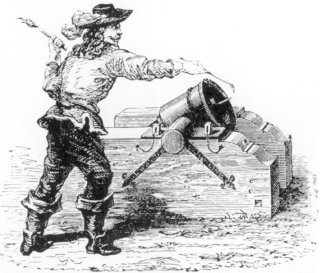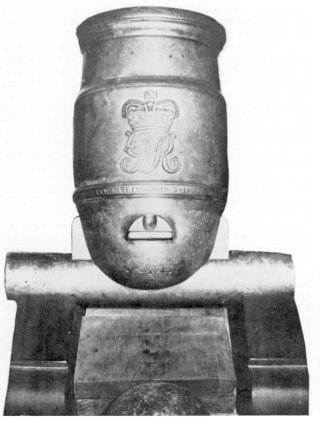

 The South African
The South African
By Felix Machanik, MB, B.Ch, M.Ch, ORTH
In order to make the weapon more authentic in appearance, I made the base or "carriage" for it out of 3" thick timber. In addition, a loose front block with the 2 front edges champhered into different angles and wedges or quoins of different angles were made of timber, to be used for altering the angles of inclination of the mortar. The trunion straps and 4 carrying handles have as yet not been made. The design of this static "carriage" was copied from a drawing in "The Age of Firearms" by Robert Held, page 119. It is possible, however, that the mortar was fitted to a mobile base with wheels.
I had not seen a similar brass mortar in the Republic or in Great Britain and, as this weapon is undoubtedly a rare find, I felt it necessary to find out something about the origin of this mortar, and my researches are recorded here.
In order to cover the subject fully, I, therefore, give a description of the weapon itself; an interpretation of the markings; some photographs; and a short summary of the historical background of the manufacture of cannon in England from the earliest times to the early 19th century. In this regard iron cannon must be included, but a special note is made of brass cannon.
The mortar can be described as follows:
Calibre -- 5.65"
Overall length -- 14.5"
Length of bore -- 12"
Greatest width -- 8.5"
Minimum thickness of barrel wall -- 1"
Trunion diameter -- 2.7"
Trunion length -- 3.25"
Width between the trunions -- 15"
The barrel has the Royal Cipher. There is a crown below which there is G.R. 4, the "4" being intertwined in the "G".
Below the cipher there is a 1/2" wide barrel ring on which is stamped CORNELIUS KING - 1822. Below this barrel ring and further back is a raised saucer-shaped depression or pan in the centre of which is the touchhole.
Below this at the base of the mortar there is stamped 1-1-15. On the underside in large stamps in the metal there are the letters R.F., and the figures 25; below this the figure 191.
Except for numerous surface scratches this weapon is in a very good condition.
Comment:
From its size it is of the type known as a "ROYAL".
The cipher G.R.4 is that of King George IV who reigned
1820 to 1830.
The numerals 1-1-15 indicate the weight of the mortar,
i.e. 1 cwt., one quarter, 15 lbs. (140 lbs.)
[Note: in December 2005 a reader from Canada pointed out that a cwt was not 100lbs but one-twentieth of 2240 lbs. This would mean the note (140 lbs) in the printed Journal was incorrect and should have read (155lbs) being the total of 112 plus 28 plus 15. The merits of the Metric system once again come to the fore!]
It was cast in the Royal Brass Foundry at Woolwich under the supervision of CORNELIUS KTNG, the acting-founder. One of the figures "25" and "191" indicate the number of the casting, but I cannot find out which number is the casting number and which is the number of the weapon, nor can I discover the significance of the letters "R" and "F"(1).
IRON CANNON: In the reign of Henry VIII, cannon were first cast in England. Peter Bawde, a Frenchman, who was a bell and gun foundryman or founder, cast brass cannon in Houndsditch, London, in 1525(2). Previous to this date the English kings imported cannon made in Italy or Germany. About 1535 JOHN O'EWEN, another gun founder, was active. Sussex was the centre of the iron trade in Britain and thus became the centre for the manufacture of iron cannon.
By 1543 gun foundries were flourishing at Uckfield and Buxted in Sussex(3). Henry VIII had sent Peter Bawde from London to Sussex and this artificer gave instructions to Ralphe Hogge and his co-workers there in the art of casting cannon.
The iron foundry at Sussex supplied iron guns to the ships of queen Elizabeth I. Between 1650 and 1787 the Fuller family ran the foundry. The existing foundry was enlarged and others were formed. Originally they were under John Fuller who stamped his initials J.F. on the trunions of the guns cast by him. At the end of the 18th century the forests of Sussex were depleted of timber. The gun foundry was then moved to Carron, near Falkirk, where there was an abundance of coal and iron. Short-barrel carronades were produced here for the Navy its 1812 and 29 pounders were made for LORD WELLINGTON who would not use anything but a "carron".

Soldier firing a Mortar and Bomb-shell requiring double ignition -
(Acknowledgements to W. W. Greener "The Gun and its Development",
Cassell & Co. Ltd., London, 1881.)
BRASS CANNON: As mentioned above, as early as 1725 brass cannon were made in London, but then the art was transferred to Sussex and mainly iron cannon were made there, especially for England's growing Navy. In 1704 a gun foundry was established in Windmill Street, London, by MATTHEW BAGLEY who was a bell founder. He, his wife and some other people were killed in 1716 when a cannon exploded. The gun foundry was then moved to Woolwich in 1716, this being the date on which the Woolwich Arsenal was founded.
Brass muzzle loading field artillery was made at Woolwich from 1716 to about 1860. In England there was no expert foundryman to take over from MATTHEW BAGLEY, thus a MR. SCHALCH, aged 23, was invited over from the French foundry at Gouai. Although so young, he was placed in charge of the Woolwich Arsenal in 1716. Woolwich only made brass cannon, all iron cannon being made in Sussex (later at Carron). SCHALCH retired in 1770 when a Dutchman, JAN VERBRUGGEN, was brought over from The Hague to be chief foundryman at Woolwich. He died in 1786.
In 1786 JOHN and HENRY KING, two English brothers, succeeded him(4). Little is known of CORNELIUS KING. He was a son of JOHN KING and is first mentioned working at the foundry at Woolwieh in 1785. He was then an apprentice, which indicates that he was between 14 and 21 years old. In 1805 he was appointed foreman at the Brass Foundry and in 1813 assistant founder. His father, JOHN KING, the Master Founder, had died in this latter year and his uncle, HENRY KING, was appointed in his place. In 1818 HENRY KING retired and the post of Master Founder was abolished.

Top view of mortar in author's possession
CORNELIUS KING, however, remained in charge with the rank of Acting-Founder. I have not been able to find out any more about the life of CORNELIUS KING, nor the date of his retirement or death(4).
In 1858 the last brass mortars were made at Woolwich.
It is interesting to mention the probable use of this type
of mortar. A solid iron ball could be fired, mainly against
forts, stockades or ramparts for demolition purposes, i.e.
as siege guns. The mortar could also be loaded with many
smaller pieces of lead or iron against massed troops at close
range with devastating effect. Sometimes red-hot iron shot,
heated in a charcoal fire on the battlefield, was fired. Later
in the 16th century, explosive bombs or grenades were fired.
They were called bomb-shells and were hollow balls filled
with gunpowder with an external fuse which had to be lit
before the mortar itself was fired, in other words, double
ignition. A dangerous procedure, to say the least, because,
if the mortar did not fire, the bomb-shell would explode
in the barrel of the mortar with disastrous results to the
bystanders.
By 1580 or earlier, a bomb-shell with sealed ignition was invented. The slow match of the bomb-shell protruded into the powder in the mortar and was set alight as the powder ignited. The mortar bomb would thus explode a little time after it had left the muzzle of the mortar above the heads of the enemy or in their midst.
Where or when this brass mortar was used in South Africa one hundred or more years a go is shrouded in the mists of time, but we know something of its maker, CORNELIUS KING, whose name is stamped deep in the metal for all to read. This important and rare piece of South African military Africana will one day find a permanent home in the South African National War Museum.
REFERENCES:
1. Mr. A. Norris Kennard, F.S.A.(Assistant to the Master of the Armouries in Her Majesty's Tower of London). Personal communication.
2. "Gun and its Development" by W. W. Greener. 1899. Page 30.
3. Holinshed. (Ref: Chronicles of England, Scotland and Ireland,
Volume III, part I], page 960. Published 1577.)
4. "Arms and Armaments" by Charles ffoulkes, published by George
Harrap & Co.
Return to Journal Index OR Society's Home page
South African Military History Society / scribe@samilitaryhistory.org